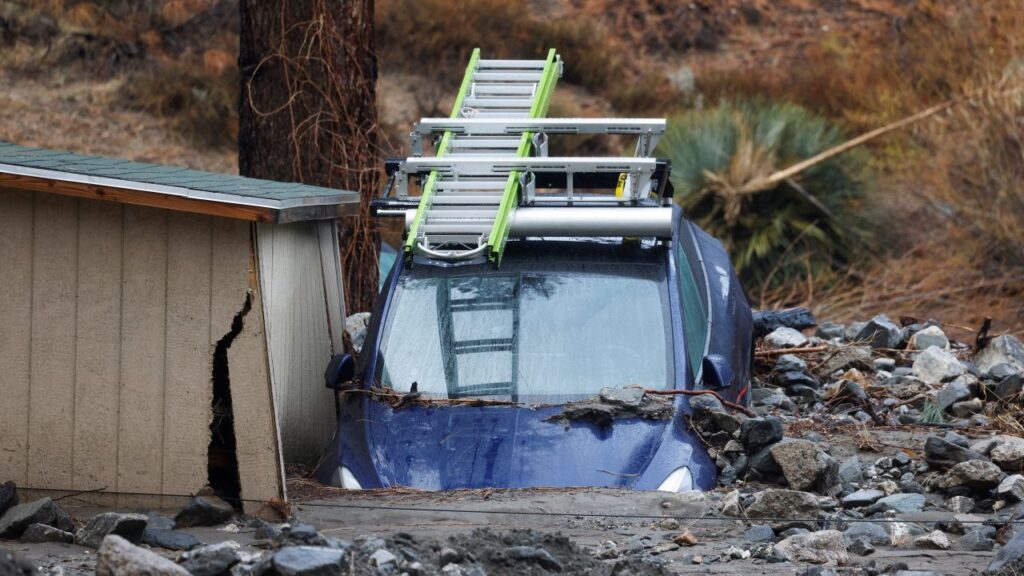Share
Severe drought is gripping most of California, but its misery isn’t spread equally. While most of the state compares today’s extreme conditions to previous droughts, people in Tulare County speak of drought — in the singular, as in a continuous state of being.
“The drought has never stopped in north Tulare County. It never left,” said county Supervisor Eddie Valero. “Domestic wells are drying up at an alarming rate.”

By Julie Cart
CalMatters
The entire West is suffering from extreme dryness, heat, and fire risk, and the small, rural towns of northern Tulare County, outside of Visalia, are caught in its vortex.
While officials around the state are devising strategies to restrict or conserve water, here in the upper San Joaquin Valley there isn’t much in the way of water to begin with. The spigot, for farms and for households, has been constricted to a trickle. For many residents, water comes in a bottle, delivered year-round by a truck from a county or social service agency.
An oft-repeated phrase in Tulare County is that there are more cows than people, and it’s true, thanks to a long tradition of dairy farms. This is a lonely place: about 92 people per square mile compared to the state average of 240.
Early settlers in this region were Okies fleeing the 1930s Dust Bowl, pushed by drought into a valley that is now suffering its own insistent drought. For many, it’s a choice to live with elbow room, out of the reach of nosy neighbors or the government’s long arm. For others, it’s simply the place where they grew up and love. And some are here because they are trapped in a financial rut with barely enough money to stay and too little to move away.
Tulare County Sits Astride the Valley Floor and Mountains
About 50,000 residents of Tulare County — 10% of its population — are designated as “water insecure,” which means their drinking water supply is unreliable or nonexistent, according to county officials. Many are Latinos, who make up two-thirds of the county’s population. Entire communities have no connection to water systems, wells are old and failing, and many water sources are contaminated by fertilizers and pesticides.
During the last statewide drought, more than 2,600 dry wells were self-reported by residents in California, about 50% of them in Tulare County. Many were in a single town, East Porterville. The largest proportion of failed wells are for residential use, not agriculture, so for many families, just taking a shower means using buckets or hooking hoses to neighbors’ homes.
The drought is an awful burden here, but it’s not the only factor adding to the county’s misery index. Its homes have half the value of California’s average, and they have less access to broadband or computers. More than a quarter of the county’s residents live in poverty, almost twice the national average. Tulare County ranks at the highest extreme for social vulnerability, according to a Centers for Disease Control and Prevention index that factors drought in its assessment.
For those whose fortunes depend on water, the debilitating drought of the last decade has been a bleak time. Suicide hotline numbers are listed on the webpage of Tulare County’s Agriculture Commission alongside the annual crop reports.
It’s a region that demands grit and rewards resilience. In the town of Orosi, a large sign in front of El Monte Middle School (Home of the Lobos) proclaims, “Let Obstacles Become Opportunities.”
A White Pickup Truck and a Shovel
John Werner knew he was a bona fide farmer the first time he filled out an IRS Schedule F form, an option open only to those who farm as a business and can show a profit. He qualified for the first part: He grows olives, peaches, figs, and hay on his own 60 acres. The profit part has proved more difficult.
“I grew up poor, out in the country,” said Werner, who lives outside of the small town of Seville in the Sierra Nevada foothills. “I thought the rich guys drove white pickup trucks and had shovels in the back.”
As a lifelong resident of Tulare County, Werner knew that scratching crops out of dry ground was never going to support his family of five. So he has worked as an adult education supervisor for two counties. “If I didn’t have a day job, I would’ve had to sell.”
Werner was lucky that his property sits on an aquifer so he drew water for his house and farm from two shallow wells. But his luck ran out, tracing the same path of the quickly depleted groundwater. His agricultural well went bad, and he drilled a new domestic well for his home that reaches as far down as it can go.
Today, the idea that water can be found at a 60-foot depth is not remotely feasible. He’s drilling a new agricultural well to bedrock, about 280 feet down. The digging and the pumps don’t come cheaply; they can set farmers back $60,000, and sometimes much more.
The unrelenting heat, which sucks moisture from the soil, makes matters even worse, negating even the most thorough watering. Hay can be dry-farmed, surviving on rain — if there is any. Werner has already lost his hay crop to drought this year.
“Normally I harvest around Easter,” he said. “The week prior I was standing out there and the hay, which should have been about three feet tall — in a good year I’ve had it up to five feet — was seven to eight inches. Turned into dust.”
Climate change is a driving factor in much of the region’s new weather landscape, with this year spiking on all the graphs for rain, heat, and soil aridity. Last month was the driest May in Tulare County in 127 years of recordkeeping, and so far 2021 is its sixth-driest year in recorded history, with less than three inches of rain, about a third of average. The county has been in a drought emergency declared by the U.S. Department of Agriculture for six of the last 10 years.
Tulare County Has Been in Drought More Often Than Not
Werner used groundwater from his house pump to survive the last drought, redirecting water from the laundry to keep the fruit trees alive. Limping along on subsistence amounts of water, the trees didn’t produce for three years, but they survived. In the meantime, there’s no crop to bring in money, but it still costs to pump water, prune the orchards and maintain equipment.
Today the once-fertile valley’s soils look exhausted, hammered by persistent dryness. Since the mid-19th century, this land has been turned and tilled and whipsawed, from producing wheat and barley to cotton, fruit and nuts.
Werner is catching the tail of a pistachio trend, refinancing his property to raise money to put in the high-value trees, a decision he made before the last two dry years. Pistachios tolerate salty water and need less of it, but it’s costly to care for the orchards while waiting years for the nuts to come.
“There’s going to be losers with this drought,” he said. “Those with money will hold on. The small farming operations will have to give way to the agribusiness outfits. They are more efficient than any of us are. I hope it doesn’t break the mom and pop farmers. It’s gonna affect a lot of poor rural communities, places like Ivanhoe and Seville, towns no one has ever heard of.”
Still, each young tree or tiny seed that’s put into the San Joaquin Valley’s dusty ground is a sign of optimism, a confident investment in the future. Farmers hoping for rain, even with no rain in sight.
“This is the place where we raised our kids. It’s our home,” Werner said. “Come hell or high water, I’ve got to plant.”
Water Everywhere. Until There’s Not Enough.
Viewed through today’s lens of extreme water scarcity, it’s difficult to believe that the San Joaquin Valley has historically been notable more for its persistent and severe flooding. The backstory bears little resemblance to the Tulare region of today.
Until the turn of the century, steamboats plied Tulare Lake, the largest body of freshwater west of the Mississippi. In the 1940s homeowners in Visalia complained that cars driving through flooded streets threw up wriggling fish onto front porches. Artesian wells bubbled with warm water day and night. The valley once held a vast sea. The Kern River flowed to San Francisco.
“We still have sea mammals of different types trying to come up as far as they can on the San Joaquin, sea lions in particular,” John Austin, author of Floods and Droughts in the Tulare Lake Basin, said in an interview. “In Tulare Lake, we had sea otters, harbor seals, and sea lions. We had chinook salmon runs here. When the Spanish showed up they saw the Indians swimming under water after salmon.”
It was a land of plenty, with plenty of water. Farming began to take hold when people passing through the valley to make their fortunes in the California goldfields lingered on their return trip south, busted and broken.
In time those 49ers began the water engineering that would transform the San Joaquin Valley. In the late 1800s, dryland farming produced the nation’s largest wheat crop. Then, with the New Deal, rural electrification, and the invention of centrifugal pumps, more and more water was siphoned from vast underground stores.

Using a local invention known as the Fresno Pan, farmers scraped out canals to redirect river water to thirsty crops. By 1906, the Kings River, the biggest of the valley’s four major rivers, was irrigating more than a million acres. And the irrigated land made farmers rich.
“They grew plums, cotton, grapes, and citrus,” said Austin. “It was possible because they had land, children for labor, sunshine. And now they had water.”
Madera Neighbors Helping Neighbors — With Water Tanks and Hoses
The road to Jim Myers’ house offers a clue as to what has been taking place in the wide fields for decades: Rusting farm machinery, odd parts and plows, are repurposed into yard art. There’s a small broken-down tractor that’s a centerpiece in a cheerful new garden Myers created.
Most residents in the area are farmers, or used to be. Roads are defined on both sides by irrigation ditches. Regimented rows of trees pass like a dizzying kaleidoscope. Shimmering heat rises.
It’s 106 degrees outside at Myers’ home and he motors out to meet the delivery of a 2,500-gallon water tank, a service facilitated by Self Help Enterprises, a non-profit that will pay to keep the above-ground tank filled with water.
Myers is in the driveway, sitting sidesaddle on a small red ATV that he’s using as a motorized wheelchair. A former mechanic, Myers lost his foot in a workplace accident and is on disability.
Like everyone in his community near Madera, just northwest of Tulare County, he and his wife get their water from a well. And, like many people, his wells have failed to reach the sinking water table.
His first well, sunk to 200 feet, gave out in the last drought, and his second, at 300 feet, went dry last week. “We went to turn the water on, and, boom, it just ran out.”
The new water tank, while welcome, is not a long-term solution. Some valley residents are attempting to finance their way out of the drought through second mortgages and bank loans. Myers, 62, said he has been trying to pay down his mortgage but will have to get a personal loan to dig a new well.
But that isn’t sustainable, either. Experts say the efforts to drill deeper and deeper wells are depleting aquifers, and in many areas eventually will reach water too saline to drink or irrigate crops.
While they waited for their water delivery, Myers and his wife made do with a neighbor’s garden hose jury-rigged to bring water into their home, where they’ve lived for 20 years. To avoid running up his friend’s bills, the couple used the water sparingly and only during times when the rates were lowest — between midnight and 4 am.
“Everybody is suffering, it’s why I have all this gray hair,” he said with a laugh.
The drought response of local non-profit organizations has ramped up significantly, with daily deliveries of bottled water, assistance in getting new wells, and help in connecting to water systems.
Calls to Self Help Enterprise’s water hotline have quadrupled in recent months, said Marliez Diaz, who oversees the group’s water program, which is partially funded by state grants.
“I don’t think many of our residents have the option to leave,” she said. “They’re just very grateful that they have our tank water and they’re trying to conserve as much as they can. They’re just holding on. We’re kind of their last and only hope.”
Luzvianey Gonzalez, who lives in Madera, in one of the 350 households that have received a water tank from Self Help in recent months. She has been showering at her sister’s house since May, when her well dried up.
It’s a commonplace workaround. Diaz has her own firsthand experience with water insecurity. Her family’s well gave out during the last drought and they, like the Myers household, relied on a garden hose for a time. The family went to a relative’s house to shower, cook and do laundry, then went home to sleep.
Like others in the region, the Diaz family couldn’t afford to put in a new well so her father took a job with a drilling company.
The stress of drought seems to pile heavily on top of everything else. Myers said two of his grown children’s friends committed suicide. He’d move away if he could afford it.
“I know it’s nature, but I’m just tired of what’s been going on,” he said.
No Plan B When the Water’s Gone
Tulare County supervisors are housed in a streamlined, modern building in Visalia, the county seat. The lobby displays various historical artifacts, among them a framed, yellowing 19th century map of the county, a lavishly illustrated sales pitch for the nation’s agricultural powerhouse that boasted: “Bounteous stores of water. Abundant streams of surface water and untold volumes subject to Artesian flow. The greatest Artesian Basin in the world.”
All true but, alas, all gone.
Denise England is attempting to get a handle on what’s left, mapping and measuring the county’s aquifers and wells. As water resources planning director, part of her job is to quantify the local water supply and use.
It’s surprisingly difficult. Given water’s central role, England is not happy to say that she’s still “getting my arms around” groundwater in a region where four counties share a single unconfined aquifer. What maps there are have proven inaccurate. This is not a region connected to networks of municipal pipes and treatment plants like much of urban California. Most communities get their water from wells, and there’s no reliable count of how many have gone dry.
“A lot of our wells have gone dry,” England said. “I don’t know what the future holds.”
Dryness here has become so omnipresent that England quickly reconstituted a drought task force disbanded after the last drought with hardly a noticeable pause. Emergency services instituted during the last drought remain in place.
“Even when the (last) drought ended we still had bottled water delivery, ran a tanks and hauled-water program and private well assistance,” she said. “We know communities are already struggling with this drought. A lot of people are white-knuckling it.”

“If you don’t have the water for the crops in this great fertile land, what do you do?” — Amy Shuklian, Tulare County supervisor
The entirety of Tulare County is classified as being in extreme drought, and last month the Board of Supervisors declared a drought emergency.
“What that gets us, how that helps, we don’t know,” said board chair Amy Shuklian. “What’s our battle plan? It’s not a battle against any one entity, it’s a battle against the drought.”
In many places, the drought is already winning.
“You see people pulling up orchards, or just not farming land because they don’t have water anymore,” Shuklian said. “I know dairies that have sold out, and they’re planting trees where the cows were. The oldest dairy in the state sold everything last year. I have a friend who in the last couple of years sold off all his farming land and used the money and went into commercial real estate — yeah, out-of-state commercial real estate.
Signs of entrenched drought are everywhere, she said.
“These areas that have gone fallow, we’re seeing huge solar farms. We have the most fertile land around and it’s going to solar panels. But if you don’t have the water for the crops in this great fertile land, what do you do? You have to make a living.”
The drought-driven stressors are innumerable, county officials say: an uptick in the need for social services, mental health services, and food assistance programs, while unemployment rises and the tax base falls. The region’s fiscal fortunes are intertwined with agriculture, a tenuous tether as drought intensifies.
County Supervisor Dennis Townsend said he’s heard estimates that as much as 20% of the region’s farmland is being fallowed because of lack of water.
“Agriculture is our economy. You harm it and you harm every industry in the valley,” he said. “It’s the probability of what’s going to happen that worries me. If we do lose farmland, what is Plan B?”
About the Author
Julie Cart joined CalMatters as a projects and environment reporter in 2016 after a long career at the Los Angeles Times, where she held many positions: sportswriter, national correspondent and environment reporter. In 2009 she and colleague Bettina Boxall won the Pulitzer Prize for Explanatory Reporting for their series on wildfires in the West. CalMatters is a public interest journalism venture committed to explaining how California’s state Capitol works and why it matters.



















